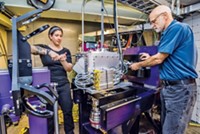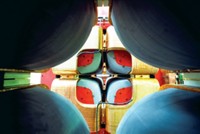Advertisement
Grab your lab coat. Let's get started
Welcome!
Welcome!
Create an account below to get 6 C&EN articles per month, receive newsletters and more - all free.
It seems this is your first time logging in online. Please enter the following information to continue.
As an ACS member you automatically get access to this site. All we need is few more details to create your reading experience.
Not you? Sign in with a different account.
Not you? Sign in with a different account.
ERROR 1
ERROR 1
ERROR 2
ERROR 2
ERROR 2
ERROR 2
ERROR 2
Password and Confirm password must match.
If you have an ACS member number, please enter it here so we can link this account to your membership. (optional)
ERROR 2
ACS values your privacy. By submitting your information, you are gaining access to C&EN and subscribing to our weekly newsletter. We use the information you provide to make your reading experience better, and we will never sell your data to third party members.
Physical Chemistry
Element 118 Detected, With Confidence
High-energy experiments yield three atoms of superheavy nuclide
by Mitch Jacoby
October 17, 2006

An experiment begun in 2002 has produced three atoms of the heaviest superheavy element yet—element 118—according to a team of researchers from Russia and the U.S. On the basis of the number of protons in its nucleus, the new element belongs just below radon in the periodic table.

Scientists at the Joint Institute for Nuclear Research in Dubna, working with colleagues from Lawrence Livermore National Laboratory in California, bombarded a target enriched in californium (249Cf, containing 98 protons) with an energetic beam of calcium ions (48Ca, with 20 protons). After thousands of hours of bombardment, the team claims to have detected three series of correlated nuclear events that signify the creation and nearly instantaneous demise of three atoms of element 118. The results have been published in Physical Review C (2006, 74, 044602) and were announced on Oct. 16 in a telephone press briefing by members of the Livermore group.
Typically, isotope-synthesis experiments yield an enormous number of energetic particles, including some species that survive very briefly before disintegrating via α-decay and spontaneous fission events. Sophisticated detectors are used to keep track of the positions and times at which the events occur and to measure the kinetic energy and other properties of the short-lived particles. By combing through the data sets, researchers aim to uncover correlated events that can be identified as the signatures of creation and often the subsequent disintegration of heavy nuclides.
In 2002, the team observed the creation of a single atom of 294118, which fell apart through a chain of events involving three α-decays (to elements 116, then 114, then 112) followed by spontaneous fission. But as Kenton J. Moody, a heavy-element group leader at the Livermore lab, explained at the press briefing, the team wanted to reproduce the findings. So they repeated the experiments several months ago and observed the telltale signs of two more atoms of element 118.
The heavy-element team, led by Dubna group leader Yuri T. Oganessian, is made up of some 30 scientists, including Moody and Livermore coworkers Dawn A. Shaughnessy, Nancy J. Stoyer, and Mark A. Stoyer. In recent years, the team has reported the discovery of four other new elements: 113, 114, 115, and 116.
Detector noise and other random events that could possibly mislead the researchers are very unlikely—less than one part in 100,000—Nancy Stoyer noted. "I would say we're very confident."
Sigurd Hofmann, a leading nuclear scientist at the Institute for Heavy-Ion Research (GSI), Darmstadt, Germany, also is confident of the results. "All the new information fits together very well," Hofmann says. Taken together with the large collection of results observed over the years by the Dubna-Livermore team, the newest experiments help provide a complete and "believable" picture of the heaviest elements, Hofmann remarks.
Initial sightings of element 118 were reported in 1999 by researchers at Lawrence Berkeley National Laboratory. But that claim was later retracted in a well-publicized case of research fraud (C&EN, Aug. 6, 2001, page 10). At the time, GSI's Hofmann commented that the retraction "doesn't touch the possibility of synthesizing element 118 in the future." Apparently, the element's time has now come.




Join the conversation
Contact the reporter
Submit a Letter to the Editor for publication
Engage with us on Twitter